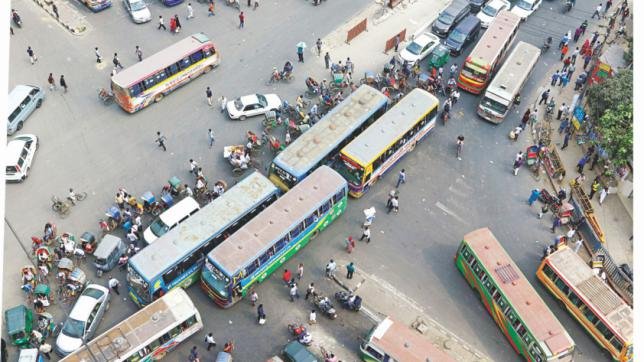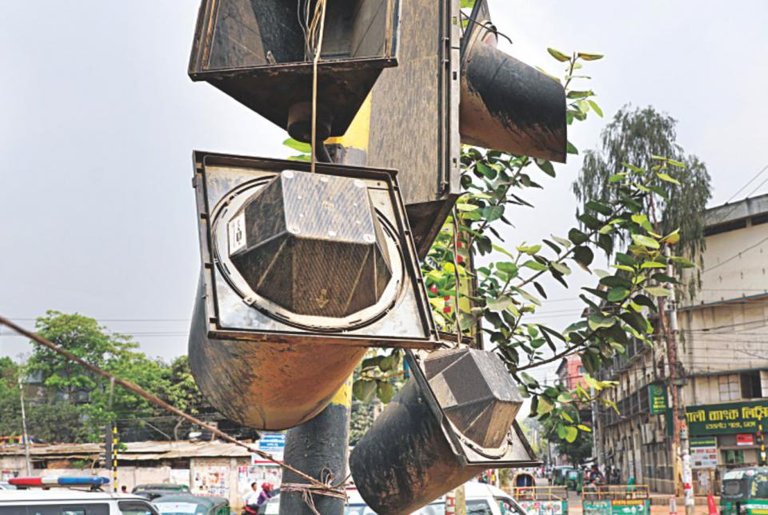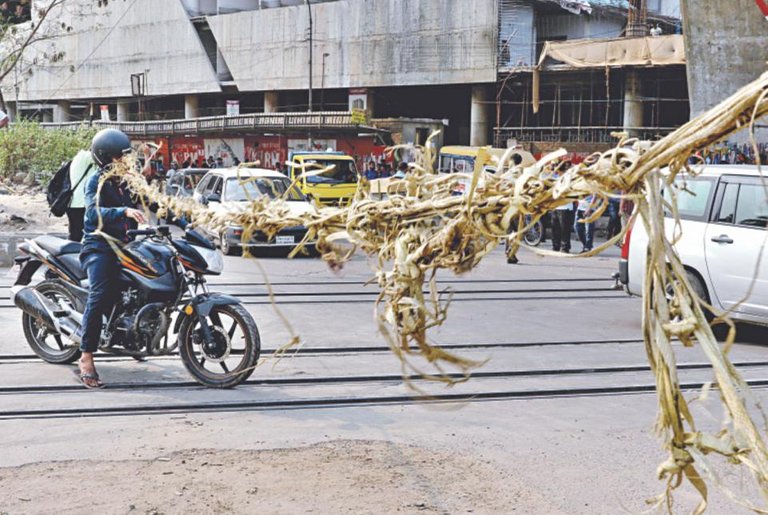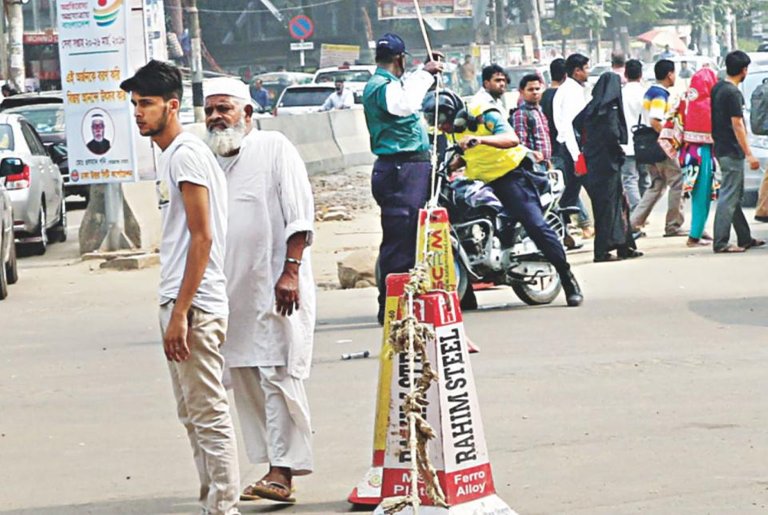City authorities have tried out a host of “solutions” to control chaotic traffic over the decades. The result? All the money went down the drain and the situation turned from bad to worse.
After bamboo and rope fences, manual traffic lights turned digital at the capital's intersections in 2004 to ease traffic movement.
Nine years later, the system was upgraded with electronic countdown timers and solar panels. The two projects cost Tk 37 crore but in the end public money was more or less wasted.
Dhaka South City Corporation and the World Bank, lender of previous projects, now look for a third option to make the system effective. After several years of deliberation, they think a "semi-automatic" approach, combining digital and manual options, would do the trick.
Under a fresh plan, traffic police would carry remote controls to switch green and red lights assessing traffic flow, said officials and experts involved in the initiative.

Traffic chaos on Dhaka streets as vehicles and pedestrians Traffic chaos on Dhaka streets as vehicles and pedestrians ignore rules and go about as per their wish. Ropes, cones and even bamboo fences have been used to control traffic. At most intersections, the traffic lights are either broken or not used as policemen prefer signalling by hand. Yet, money is now being spent to buy remotes for the lights.
At least 134 remote controls would be imported from India within this month spending Tk 50 lakh.
"The first two options failed as none of them were applicable for this chaotic city. You can't introduce a pre-fixed system when traffic flow is unpredictable in Dhaka," said Prof Shamsul Hoque, an urban traffic expert teaching at Buet's civil engineering department.
He said the past initiatives were taken without properly assessing the ground realities: plying of mixed vehicles (motorised and non-motorised), movement of pedestrians, sudden changes in traffic flow on streets due to VIP movements and various programmes on the streets.
For example, a political rally in Suhrawardy Udyan halts traffic in a large portion of the capital and the rest suffers from the spill over.
Prof Shamsul, who was engaged by the WB and the Dhaka South City Corporation to make the ineffective system effective, was surprised to know that no traffic engineer was involved in the project.
"The semi-automatic system will work only if city dwellers are educated about it and encouraged to follow."

Traffic chaos on Dhaka streets as vehicles and pedestrians ignore rules and go about as per their wish. Ropes, cones and even bamboo fences have been used to control traffic. At most intersections, the traffic lights are either broken or not used as policemen prefer signalling by hand. Yet, money is now being spent to buy remotes for the lights. The photos were taken in Bijoy Sarani, Gulshan and Mohakhali areas.
At least 134 remote controls would be imported from India within this month spending Tk 50 lakh.
"The first two options failed as none of them were applicable for this chaotic city. You can't introduce a pre-fixed system when traffic flow is unpredictable in Dhaka," said Prof Shamsul Hoque, an urban traffic expert teaching at Buet's civil engineering department.
He said the past initiatives were taken without properly assessing the ground realities: plying of mixed vehicles (motorised and non-motorised), movement of pedestrians, sudden changes in traffic flow on streets due to VIP movements and various programmes on the streets.
For example, a political rally in Suhrawardy Udyan halts traffic in a large portion of the capital and the rest suffers from the spill over.
Prof Shamsul, who was engaged by the WB and the Dhaka South City Corporation to make the ineffective system effective, was surprised to know that no traffic engineer was involved in the project.
"The semi-automatic system will work only if city dwellers are educated about it and encouraged to follow."

Traffic chaos on Dhaka streets as vehicles and pedestrians ignore rules and go about as per their wish. Ropes, cones and even bamboo fences have been used to control traffic. At most intersections, the traffic lights are either broken or not used as policemen prefer signalling by hand. Yet, money is now being spent to buy remotes for the lights. The photos were taken in Bijoy Sarani, Gulshan and Mohakhali areas.
However, urban planner Khondker Neaz Rahman is not optimistic at all. "No initiative will work if the reasons for the previous attempts failing are still there."
If a system failed to control traffic or could not make sure that commuters follow traffic rules, then it would not work, said Neaz who travels between Motijheel and Uttara regularly.
The Daily Star recently emailed the WB office in Dhaka to know why the first two attempts failed; whether any feasibility studies were conducted and if so, what were the findings.
In response, the WB explained difficulties in establishing digital traffic system in the city but side stepped the questions about feasibility studies.
"Dhaka faces one of the world's most complex and difficult traffic situation. Its road infrastructure space is only 7.5 percent compared to the global standard of more than 20 percent. The city must take urgent actions in a number of areas to ease the traffic congestion," said Shigeyuki Sakaki, senior transport specialist there.
He said, "Traffic signal -- aimed at better managing the intersections -- is one piece of the puzzle. It will not itself solve Dhaka's traffic congestion, but to manage such scale of traffic, an effective traffic signal system is a necessity."
Sakaki insisted that Dhaka required a unique approach for intersection management to address different traffic conditions, including frequent VIP movements, weak road network, and high traffic during rush hours and vehicles blocking intersections.
Sources at the DSCC said studies were carried out but the known ground realities were not considered as both the lender and the DSCC were keen on going ahead with the project.
The WB official said learning from the earlier pilot projects, Dhaka Metropolitan Police (DMP) with support from the DSCC and DNCC in February initiated a remote-control system at four intersections. Based on the feedback, he said the DMP would adjust the final design and roll it out to 91 intersections.
"It will happen in phases to allow time for awareness generation among traffic police and road users … ."
DSCC Executive Engineer Shehab Ullah, who looks after the traffic signal initiative, came up with similar explanations. He told The Daily Star that congestion could not be eased due to plying of different kinds of vehicles on the streets, indiscriminate stopping of vehicles, and jaywalking.
When timers and solar panels were added to the traffic lights in 2013, Shehab had claimed success.
He is now also hopeful about the semi-automatic system. "In February, traffic department had trial runs of the remote controls at intersections of Gulshan-2, Bijoy Sarani, Banglamotor, and Sheraton for several days and the outcome is positive.”
Like the previous two projects, a number of officials visited multiple countries, including India and China, to see how traffic flow was being regulated with remote controls. More officials are likely to visit India next month to see the factory that make the remotes.

Traffic chaos on Dhaka streets as vehicles and pedestrians ignore rules and go about as per their wish. Ropes, cones and even bamboo fences have been used to control traffic. At most intersections, the traffic lights are either broken or not used as policemen prefer signalling by hand. Yet, money is now being spent to buy remotes for the lights. The photos were taken in Bijoy Sarani, Gulshan and Mohakhali areas
Mosleuddin Ahmed, joint commissioner (traffic north) of DMP, said during the trial phase they found the remote controls did not function well. "The Indian firm has been informed of the problems. We will do trial runs again once the company supplies modified versions of the remote controls."
Traffic congestion in Dhaka eats up around 5 million working hours every day and the average speed of vehicles during rush hours has come down to 5kmph, according to the Accident Research Institute of Buet.
The congestion causes an annual loss of between Tk 20,000 crore and Tk 55,000 crore, says ARI, citing findings of organisations working on the issue.
“However, about 50 to 70 percent of the losses can be avoided through proper actions,” ARI Director Prof Moazzem Hossain told a roundtable recently.
Congratulations @joy69! You have completed some achievement on Steemit and have been rewarded with new badge(s) :
Click on any badge to view your own Board of Honor on SteemitBoard.
To support your work, I also upvoted your post!
For more information about SteemitBoard, click here
If you no longer want to receive notifications, reply to this comment with the word
STOPDo not miss the last announcement from @steemitboard!
Nice post
Comment Spam